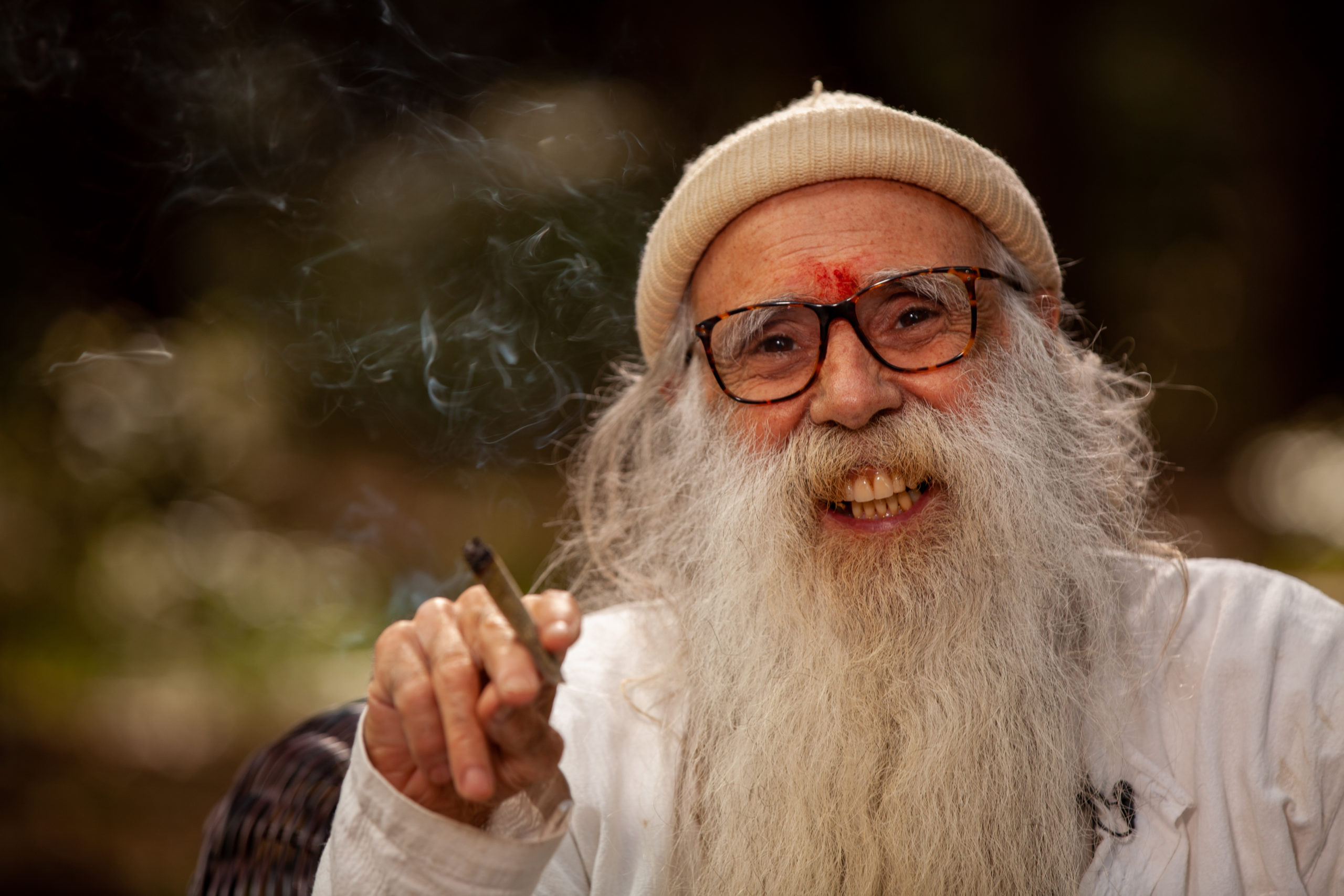For years, no one told us about the spiritual dimension of cannabis. We had no Ganjiers around to give us an idea of its long history both as a medicine and as a sacrament. On the contrary, we were told she was the “Devil’s Weed” and would drive us crazy.
The decades of stigma and persecution notwithstanding, the spiritual essence of the cannabis flower is today more and more recognized. How this came about is a testament to the spiritual power within cannabis. The Divine Consciousness within the plant itself has taught us to revere Her as a manifestation of the Divine Feminine.
I can only conclude that it must be she herself, as the female of the species, who has revealed this sacred quality at the core of her nature, because, as I said, no one told us about it. Rather, thousands of years of medical, inspirational, religious and sacramental uses of cannabis were erased from history and cannabis consumption in any form was driven underground. The authorities were so fanatic about obliterating cannabis they even proscribed the use of Hemp, the world’s most useful plant, but one without the mind-altering effects of its sacred cousin.
Nevertheless, the innate spiritual dimension of cannabis is revealing itself. The sacred herb has been in the forefront of the growing recognition of plant medicine as a spiritual force. Part of this development can be attributed to the chemists’ discovery of psychedelics as well as ethnobotanical investigation of plant-based entheogens and the latter’s use even today by tribal shamans around the world.
I see cannabis as the “everyday” entheogen. Other substances such as LSD, MMDA, mushrooms, peyote, ayahuasca, etc., require a commitment of time because the effects are so strong and long lasting. They are all a “trip.” Whereas cannabis alters one’s consciousness in more subtle ways, so it can be used every day as an ally. When used as a sacrament in a ritual, its effects can be directed toward spiritual work.
Nevertheless, a strong dose of edible cannabis, such as the famous Bhang in India or a big hit of RSO or eating a chunk of hashish, can launch one on an out-of-body experience, which for the unprepared, can be rather frightening, but for the initiate, becomes a spiritual journey to the center of one’s own consciousness.
Groups are forming around sacramental use of the sacred herb. Other groups are creating religious ceremonies centered on mushrooms, cactus and ayahuasca. More books about ceremonial rituals centering on cannabis and other plant allies are coming out every year. Researchers are discovering hidden references to and evidence of cannabis use in numerous cultures and religions throughout human history.
Some of the earliest evidence of the sacredness of the plant comes from archeological digs in ancient caves in far western China, where the arid climate has preserved the medicine kits of early shamans for nearly five thousand years. Included was a pouch containing cannabis buds that still had a measurable bit of THC. It was found next to various ritualistic instruments used for healing. Traditionally, shamans invoke divine assistance to empower their herbal preparations.
Various grave sites, or Kurgans, have been excavated in the Steppes of Russia revealing cannabis use by the long gone tribal cultures, among them the ancient Scythians, a horse riding culture that spread from Uzbekistan to the Ukraine.
Chinese medical treatises include recipes for cannabis from 2800 BCE and they would invoke the Hemp Fairy to help them in the cure. In Korea, ritual attire for priests and the family at a funeral were made from hemp as the sacred cloth to facilitate the passage to the heavenly world.
In India, as well, cannabis has a sacred purpose. Indra, the God of thunder and lightning was very fond of drinking Bhang, a libation made from cannabis and yogurt and various spices. The great Lord Siva, Master of Yoga, Meditation and Dance, likewise loves Bhang. Offerings of ganja, bhang and charas are made to both Gods, and to the Holy men and women who are their devotees. The sadhus of India are known for the hashish and tobacco chillums they pass around, exhaling clouds of smoke while chanting mantras or reading sacred texts.
Still today, during the springtime festival of Holi in India, the entire village drinks bhang or eats cannabis edibles, after which they run around exuberantly throwing dry pigments on each other, until everyone is colored from pink to red to purple.
Some of the world’s most ancient sacred compositions, the Vedic literature of Hinduism, contain numerous poem-like chants extolling the glories of a libation called Soma. Although western scholars have argued for years about the specific ingredients in Soma, recently some scholars have made a convincing argument that the basic ingredient in Soma was cannabis. While other stimulants may have been mixed in as well, Soma was a quintessential element in their rituals.
The ancient Persian Mazdean Haoma cult used cannabis as a main sacrament. Zoroaster transformed this cult, but he and his priests still used cannabis. Many groups in the Sufi branch of Islam used cannabis as an aid to arriving at a state of ecstasy through dance, the famous “Whirling Dervishes”.
Apparently, the Jews also were into cannabis as a holy herb. Modern linguistic scholarship has determined that the name of one of the main ingredients in the formula for Holy Anointing Oil in Exodus of the Old Testament has been mistranslated for centuries. It is now clear that the formula contains a large portion of cannabis, along with cinnamon, myrrh, and cassis dissolved in olive oil. All the items of worship in the Holy of Holies were wiped down with this oil and it was dabbed on the rabbi’s wrists, forehead and top of the head. Between the fumes from the oil and incense, combined with the transdermal ingestion, no doubt the priest was getting high.
Often the formulas for incense for many religions contained cannabis oil along with other essential oils, leading to smoke filled rooms of celebrants all inhaling and experiencing a group high.
All this is history, but it doesn’t quite reveal that which is sacred, holy or spiritual about cannabis itself. What is spirit and where does one find it? Do plants have spirit? Plants surely have consciousness as well as life force. When you grow cannabis with pure intention, you soon find yourself talking to them, giving them names, referring to them as “she” and “her” and as “my girls”. Over time, you learn to listen to the plants and watch them closely for signs of distress. Eventually they begin to talk to you inside your own mind.
Science has discovered that we have an internal cannabinoid system, one of whose functions is communication between vital bodily organs in order to regulate the harmonic balance within the body as a whole. It seems to me that these internal cannabinoids are the receptors for the telepathic messages sent from the plant’s phyto-cannabinoids. And these cannabinoids can also bond with other bodily receptors such as serotonin, melatonin and opioid receptors. Which is why they can augment or mitigate the potency of other psychoactive substances.
More recently, we have learned of the terpene component of cannabis. Terpenes are messengers, as well. There is a whole science of aromatherapy using fragrances to stimulate healing and peaceful states of mind. There are thousands of different terpenes produced in nature by flowers, trees and herbs which send signals and messages to animals, reptiles and insects. They work as a form of precognition informing an organism of poison or pleasure, nutrient or irritant and as such they trigger preparatory responses in the receptor organism. Many of these same terpenes in nature are found in cannabis as well.
When planted in the ground, cannabis is embedded in the local environment through its root system. Hence, when we ingest earth grown cannabis, we connect psychically with the plant kingdom and the soil as a living environment comprised of bacterial and fungal life as well as other microbes like amoebas, paramecium, ciliates, flagellates, arthropods, worms, beetles. Cannabis is a portal into the awareness of other dimensions, the realization that within the soil lives a whole world of interconnected life forms, all with consciousness.
Cannabis becomes the great teacher, the crossover point into plant, microbial and mycelia consciousness. When you get really high and focus in on some tiny detail of nature all your senses home in on that point and you can enter into the molecular consciousness of that object.
The same with music, where the listener enters into the sound and rhythm from within the music, within one’s mental sound consciousness. You become one with the experience, your consciousness merges with the object of attention, facilitated by the cannabis portal to other dimensions.
Realizing the inner consciousness of a plant, animal, insect or even a rock crystal is to realize the oneness of all consciousness and that is truly a spiritual experience, brought into your awareness by the ability of cannabis to free the mind of built-in blindnesses.
Herein lies the spiritual dimension of cannabis: She enables one to focus minutely on the immediate moment, letting one transcend the normal restricted patterns of perception to truly see, hear and sense without the normal everyday filters that confine our awareness. Thus, one can perceive the inner nature of what one is experiencing or perceiving, through merging one’s consciousness with the observed or with the experience. The boundaries of limited existence are broken down and one lives in the moment, beyond time. That’s what she does for us.
Amen, Om Nama Sivaya.


